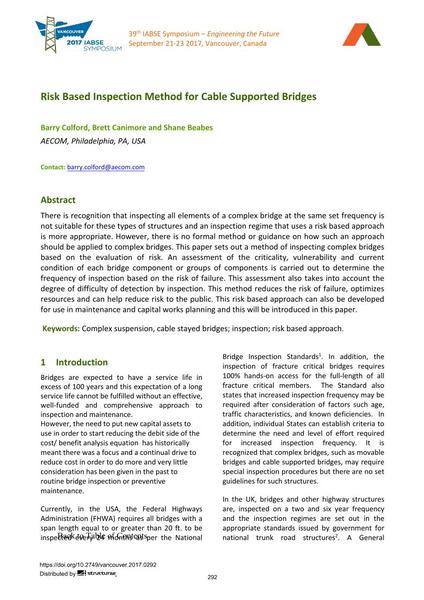Risk Based Inspection Method for Cable Supported Bridges

|
|
|||||||||||
Détails bibliographiques
| Auteur(s): |
Barry Colford
(AECOM, Philadelphia, PA, USA)
Brett Canimore (AECOM, Philadelphia, PA, USA) Shane Beabes (AECOM, Philadelphia, PA, USA) |
||||
|---|---|---|---|---|---|
| Médium: | papier de conférence | ||||
| Langue(s): | anglais | ||||
| Conférence: | IABSE Symposium: Engineering the Future, Vancouver, Canada, 21-23 September 2017 | ||||
| Publié dans: | IABSE Symposium Vancouver 2017 | ||||
|
|||||
| Page(s): | 292-299 | ||||
| Nombre total de pages (du PDF): | 8 | ||||
| Année: | 2017 | ||||
| DOI: | 10.2749/vancouver.2017.0292 | ||||
| Abstrait: |
There is recognition that inspecting all elements of a complex bridge at the same set frequency is not suitable for these types of structures and an inspection regime that uses a risk based approach is more appropriate. However, there is no formal method or guidance on how such an approach should be applied to complex bridges. This paper sets out a method of inspecting complex bridges based on the evaluation of risk. An assessment of the criticality, vulnerability and current condition of each bridge component or groups of components is carried out to determine the frequency of inspection based on the risk of failure. This assessment also takes into account the degree of difficulty of detection by inspection. This method reduces the risk of failure, optimizes resources and can help reduce risk to the public. This risk based approach can also be developed for use in maintenance and capital works planning and this will be introduced in this paper. |
||||
